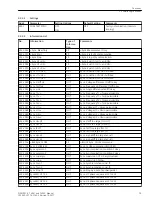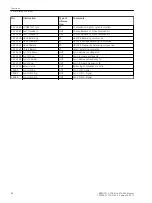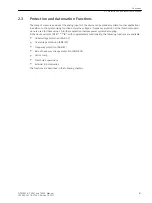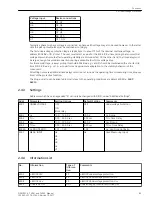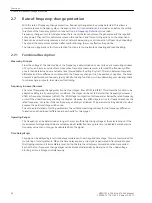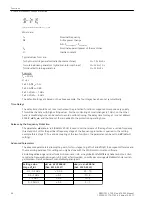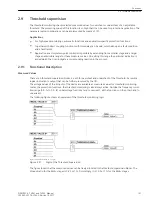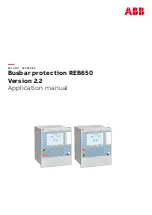
Frequency Protection
The frequency protection function detects abnormally high and low frequencies in the generator. If the
frequency lies outside the permissible range, appropriate switching actions are initiated, e.g. separating the
generator from the system.
A decrease in system frequency occurs when the system experiences an increase in real power demand, or
when a malfunction occurs with a generator governor or automatic generation control (AGC) system. The
frequency protection function is also used for generators which (for a certain time) operator to an island
network. This is due to the fact that the reverse power protection cannot operate in case of drive power
failure. The generator can be disconnected from the power system by means of the frequency decrease
protection.
An increase in system frequency occurs e.g. when large loads (island network) are removed from the
system, or on frequency control malfunction. This entails risk of self-excitation for generators feeding long
lines under no-load conditions.
Due to the use of filter functions, the frequency evaluation is free from harmonic influences and very accurate.
Functional Description
Frequency Increase and Decrease
Frequency protection consists of the four frequency elements f1 to f4. To make protection flexible for
different power system conditions, theses stages can be used alternatively for frequency decrease or increase
separately, and can be independently set to perform different control functions. The setting decides on the
purpose of the individual frequency stage. For the f4 frequency stage, the user can specify independently of
the parameterized limit value if this stage shall function as decrease or increase stage. For this reason, it can
also be used for special applications, if, for example, frequency undershoot below the nominal frequency is to
be signaled.
Operating Range
The frequency can be determined as long as there is a sufficiently high voltage at the selected input. If the
measurement voltage drops below a settable value
Umin
, frequency protection is disabled because precise
frequency values can no longer be calculated from the signal.
Time Delays/Logic
Trippings can be delayed each using an added time stage. When the time delay expires, a trip signal is gener-
ated. After pickup dropout the tripping command is immediately reset, but not before the minimum command
duration has expired.
Each of the four frequency stages can be blocked individually by binary inputs.
The following figure shows the logic diagram for the frequency protection function.
2.6
2.6.1
Functions
2.6 Frequency Protection
88
SIPROTEC 4, 7VE61 and 7VE63, Manual
C53000-G1176-C163-3, Edition 10.2017
Summary of Contents for SIPROTEC 4 7VE61
Page 8: ...8 SIPROTEC 4 7VE61 and 7VE63 Manual C53000 G1176 C163 3 Edition 10 2017 ...
Page 24: ...24 SIPROTEC 4 7VE61 and 7VE63 Manual C53000 G1176 C163 3 Edition 10 2017 ...
Page 142: ...142 SIPROTEC 4 7VE61 and 7VE63 Manual C53000 G1176 C163 3 Edition 10 2017 ...
Page 192: ...192 SIPROTEC 4 7VE61 and 7VE63 Manual C53000 G1176 C163 3 Edition 10 2017 ...
Page 222: ...222 SIPROTEC 4 7VE61 and 7VE63 Manual C53000 G1176 C163 3 Edition 10 2017 ...
Page 230: ...230 SIPROTEC 4 7VE61 and 7VE63 Manual C53000 G1176 C163 3 Edition 10 2017 ...
Page 256: ...256 SIPROTEC 4 7VE61 and 7VE63 Manual C53000 G1176 C163 3 Edition 10 2017 ...
Page 314: ...314 SIPROTEC 4 7VE61 and 7VE63 Manual C53000 G1176 C163 3 Edition 10 2017 ...
Page 316: ...316 SIPROTEC 4 7VE61 and 7VE63 Manual C53000 G1176 C163 3 Edition 10 2017 ...
Page 330: ...330 SIPROTEC 4 7VE61 and 7VE63 Manual C53000 G1176 C163 3 Edition 10 2017 ...






